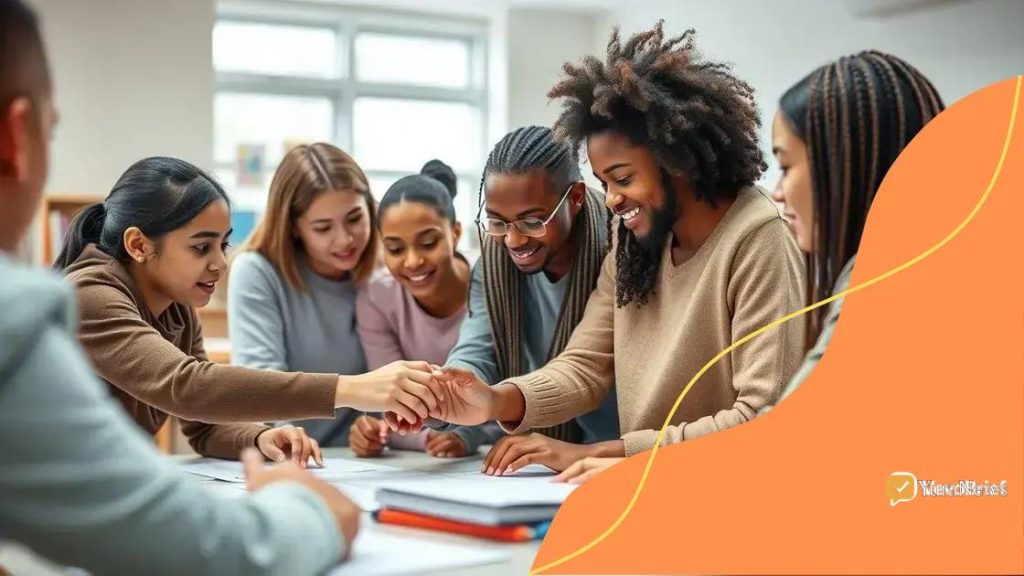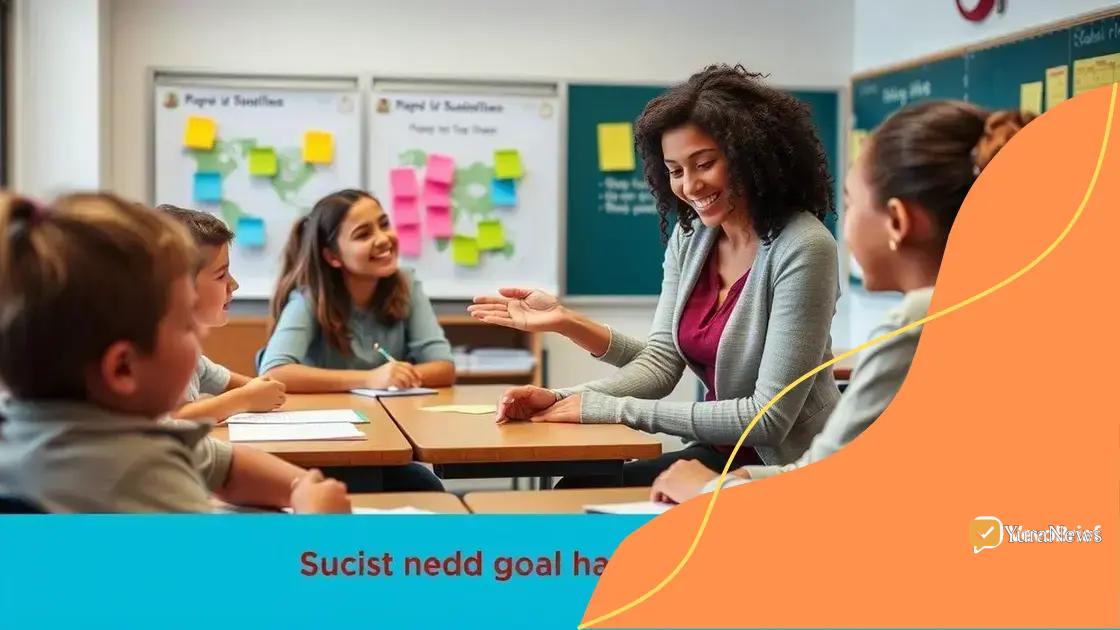Studentprogress: Unlocking Potential for Academic Success

Anúncios
Engaging students in their own progress involves goal setting, self-assessment, and promoting student voice, empowering learners to take control of their education and enhancing motivation and ownership.
Studentprogress is more than just grades; it’s about understanding how students can thrive academically. Are you curious about how to measure and enhance this progress? Let’s dive into effective strategies that genuinely make a difference.
Anúncios
Understanding the concept of studentprogress
Understanding studentprogress is crucial for enhancing a student’s academic journey. It goes beyond just grades; it involves tracking how learners develop and improve over time. One way to think about it is as a roadmap that guides students toward their educational goals.
When we discuss studentprogress, we often consider several metrics. These can include attendance, participation in class, and grades. Each of these elements provides valuable insights into a student’s learning trajectory.
Key Metrics in Student Progress
Let’s explore some of the key metrics that educators and parents can track:
Anúncios
- Grades: Academic scores can reveal areas of strength and weakness.
- Participation: Engaged students tend to show better progress.
- Behavior: Positive behavior may correlate with greater learning gains.
- Homework completion: Consistent submission can indicate responsibility and understanding.
It’s important to remember that studentprogress isn’t just about numbers. Personal growth and the development of soft skills are just as vital. Skills like teamwork, communication, and time management are indicators of progress that may not show up on a report card.
Another essential aspect is how studentprogress varies among different learners. Every student has a unique path, and understanding this is key to providing tailored support. For instance, some students may excel academically but struggle with social interactions, or vice versa.
Supporting Student Progress
To effectively support studentprogress, here are some strategies:
- Set realistic goals: Help students identify achievable objectives.
- Provide feedback: Constructive feedback can motivate students to strive for better.
- Encourage self-reflection: Allow students to analyze their own learning experiences.
- Use technology: Leverage tools that help track and visualize progress.
In sum, understanding and supporting studentprogress is a multifaceted endeavor. By focusing on both academic and personal growth, we can help students navigate their educational paths more effectively. Each student’s journey is unique, filled with challenges and triumphs that contribute to their overall development.
Key metrics to track studentprogress
Tracking studentprogress requires identifying key metrics that provide insights into how well students are advancing in their education. By focusing on specific elements, educators can assess growth and make informed decisions to support their students.
A few essential metrics should be at the forefront of any assessment of studentprogress. These include attendance, engagement in class, and assessment results. Each of these factors plays a vital role in understanding a student’s journey.
Attendance
Attendance is often the first indicator of studentprogress. Regular participation in classes can lead to improved learning outcomes. Students who attend classes consistently can absorb more information and participate in discussions, which enhances understanding.
Engagement
Student engagement also serves as a critical measure of progress. Engaged students tend to demonstrate better performance and motivation. Various factors can encourage engagement:
- Class participation: Actively contributing to discussions helps solidify understanding.
- Interest in assignments: When students choose projects that resonate with them, they often perform better.
- Utilizing resources: Seeking help and using study materials shows initiative and determination.
Another metric to consider is the quality of work produced by students. This encompasses not only homework but also classwork and projects. Assessing work quality can provide insights into a student’s understanding of the material.
Assessment Results
Standard assessments, quizzes, and tests are common tools for measuring studentprogress. These results help identify areas where students excel and where they may need additional support. Regular assessments allow for timely intervention, which can prevent students from falling behind.
In addition to traditional assessments, formative assessments can offer ongoing insights into studentlearning. These may include presentations, group projects, or reflective essays. The goal is to create a comprehensive view of a student’s abilities over time.
Incorporating feedback is also an important aspect of tracking studentprogress. Regular feedback helps students understand their strengths and areas for improvement. This constructive criticism can guide their efforts moving forward. By combining these various metrics, educators can develop a fuller picture of each student’s progress, ensuring they receive the attention and support they need to thrive in their academic journey.
Effective strategies for improving studentprogress

Improving studentprogress requires thoughtful strategies that can enhance learning and engagement. By implementing effective methods, educators can create an environment where students thrive academically and personally.
One key strategy is fostering a growth mindset. This approach encourages students to view challenges as opportunities to learn rather than obstacles. When students believe they can improve through effort, they are more likely to engage deeply with their studies.
Setting Clear Goals
Another effective method is to help students set clear academic goals. When students have specific targets, they can focus their efforts and track their progress. This not only gives them direction but also fosters a sense of achievement when they reach these milestones.
- SMART Goals: Goals should be Specific, Measurable, Achievable, Relevant, and Time-bound.
- Regular Check-ins: Frequent discussions about their goals can keep students motivated.
- Celebrate Success: Recognizing achievements boosts confidence and encourages further progress.
In addition to goal-setting, incorporating varied teaching methods can significantly impact studentprogress. Different students may learn better through distinct approaches, such as hands-on activities, visual aids, or group discussions. By mixing these strategies, educators can cater to diverse learning styles.
Utilizing Technology
Technology also plays a crucial role in enhancing student learning. Online platforms provide resources, tools, and interactive experiences that can make learning more engaging. Here are some ways technology can help:
- Interactive Learning: Educational apps can offer personalized learning experiences.
- Tracking Progress: Online grade books and dashboards allow both students and teachers to see progress in real-time.
- Collaboration Tools: Platforms that enable group work can help students develop teamwork skills.
Another important strategy is to provide constructive feedback. Ongoing feedback helps students understand their strengths and areas they need to improve. Rather than waiting for report cards, regular assessments can give immediate insights that encourage better performance.
Finally, encouraging self-reflection can empower students to take charge of their own learning. By helping them evaluate their own work and think about their learning styles, educators can inspire greater ownership over their academic journeys. When students understand their paths, they become more invested in their studentprogress.
Role of technology in monitoring studentprogress
The role of technology in monitoring studentprogress is increasingly significant in modern education. With the right tools, educators can track how students are doing and identify areas for improvement more effectively.
One important technology is learning management systems (LMS). These platforms allow teachers to post assignments, grades, and feedback all in one place. Students can easily access their performance data, which helps them understand how they are progressing. This visibility encourages responsibility and self-motivation.
Data Analytics
Another beneficial aspect of technology is data analytics. By analyzing student data, educators can identify trends and patterns that may not be obvious at first glance. For example, tracking attendance and grades can reveal whether students who show up consistently tend to perform better.
- Identifying Struggling Students: Data can help teachers spot students who may need extra support.
- Personalized Learning: Analytics can guide personalized learning paths based on performance.
- Measuring Engagement: Tools can track how students interact with course materials.
Incorporating interactive technologies also enhances studentprogress. Tools like educational apps or gamified learning platforms make studying more engaging. This can lead to increased participation and retention of information. Engaged students are more likely to excel in their studies.
Feedback Mechanisms
Another key role technology plays is in providing timely feedback. With digital assessments, feedback can be instantaneous, allowing students to understand their mistakes right away. This immediate response helps them make improvements and learn from their errors.
Utilizing online quizzes, polls, and surveys can give educators a clearer picture of student understanding in real time. This feedback enables teachers to adjust their instruction based on student needs.
Finally, using technology for communication enhances the monitoring of studentprogress. Tools such as messaging apps and video conferencing allow for better interaction between teachers, students, and parents. When everyone is involved and informed, it supports a collaborative approach to education.
Engaging students in their own progress
Engaging students in their own progress is essential for fostering a sense of ownership in their education. When students are involved in monitoring their learning journey, they are more likely to stay motivated and achieve better outcomes.
One effective way to engage students is through goal setting. Encouraging them to set personal academic goals gives them a clear direction. When students see a path to achieve these goals, they feel more invested in their progress.
Self-Assessment
Incorporating self-assessment practices can also help students reflect on their learning. This might involve regularly evaluating their understanding of various subjects. When students assess their own work, they become more aware of their strengths and areas that need improvement.
- Reflection Journals: Keeping a journal to track daily learning helps solidify concepts.
- Peer Reviews: Collaborating with classmates to provide feedback encourages critical thinking.
- Setting Milestones: Breaking down larger goals into smaller, achievable milestones can keep students motivated.
Another method to enhance engagement is the use of technology. Digital tools can facilitate self-monitoring by providing instant feedback. Programs designed for student progress tracking can help learners visualize their achievements and areas for growth.
Promoting Student Voice
Promoting student voice is a crucial aspect of engagement. When students feel their opinions matter, they are more likely to participate actively in their own education. Educators can achieve this by involving students in classroom discussions about their learning preferences and strategies.
Additionally, creating a positive environment that encourages questions and exploration can help students feel comfortable discussing their progress. When they know their teachers support them, students are more likely to take initiative in their learning.
Ultimately, engagement in their own progress helps students develop important skills like self-regulation and responsibility. By nurturing these traits, educators can equip students with the tools they need to succeed both in school and beyond.
In conclusion, engaging students in their own progress is vital for their success in education. By involving students in setting goals, self-assessment, and using technology, educators can empower learners to take control of their learning journey. Promoting a positive environment that values student voice creates a sense of ownership and responsibility. Ultimately, when students are active participants in their education, they develop the skills needed to thrive both academically and personally.
FAQ – Frequently Asked Questions about Engaging Students in Their Own Progress
What is the importance of student goal setting?
Student goal setting helps learners focus their efforts and increases their motivation to achieve educational success.
How can self-assessment enhance student learning?
Self-assessment allows students to reflect on their strengths and weaknesses, leading to more targeted improvement strategies.
What role does technology play in tracking student progress?
Technology provides tools that offer instant feedback and allow students to visualize their learning journey, increasing engagement.
How can promoting student voice benefit the classroom?
Promoting student voice fosters a sense of ownership and responsibility, encouraging active participation and collaboration among students.